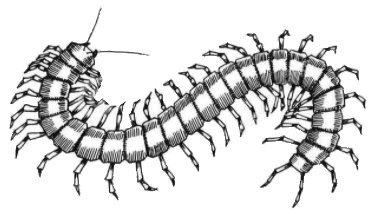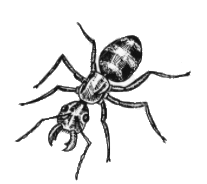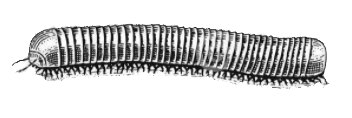
(a) Which kind of garbage is not converted into compost by the red worms?
(b) Have you seen any other organism besides red worms, in your pit? If yes, try to find out their names. Draw pictures of these.
Answer
575.1k+ views
Hint: Red worms are also called red wigglers, or compost worms, they are the ultimate compost worms, and capable of compositing all organic materials and there are a lot of advantages with the red worms like they can high temperatures.
Complete answer:
> Red worms are called compost worms, as they can convert the garbage to compost.
The process of composting by the worms is called vermicomposting.
Red worms convert all the organic garbage like rotten vegetables, fruits and rotten kitchen waste, etc but they cannot compost some of the materials like plastic, polythene covers, cloth materials, and aluminum foils, and other inorganic substances.
Red worms are arranged in bedding in a compost bin, where they eat by making the tunnels, and the food enters the mouth.
Red worms have the sensory cells where they can sense the more nutritive food, as they all enter the mouth and to the digestive system, where finally they digest and release from the anus in the form of worm castings, which increase the porosity of the compost.
> Other than red worms, compost pits also consist of some worms like earthworms, and some ants and some millipedes are found sometimes.
Earthworms also feed on the organic garbage and pass through deep and create the pores and they produce rich castings and make the compost nutrient-rich.
But earthworms can not sustain the hot temperature, so stabilization should be done.
Millipedes mainly feed on plant garbage.
Note: The important thing about vermicomposting is after they feed on the garbage they release the worm castings, they are rich in nutrients in nature and they make the soil porous which is easy for water transport to plants.
Complete answer:
> Red worms are called compost worms, as they can convert the garbage to compost.
The process of composting by the worms is called vermicomposting.
Red worms convert all the organic garbage like rotten vegetables, fruits and rotten kitchen waste, etc but they cannot compost some of the materials like plastic, polythene covers, cloth materials, and aluminum foils, and other inorganic substances.
Red worms are arranged in bedding in a compost bin, where they eat by making the tunnels, and the food enters the mouth.
Red worms have the sensory cells where they can sense the more nutritive food, as they all enter the mouth and to the digestive system, where finally they digest and release from the anus in the form of worm castings, which increase the porosity of the compost.
> Other than red worms, compost pits also consist of some worms like earthworms, and some ants and some millipedes are found sometimes.
Earthworms also feed on the organic garbage and pass through deep and create the pores and they produce rich castings and make the compost nutrient-rich.
But earthworms can not sustain the hot temperature, so stabilization should be done.
Millipedes mainly feed on plant garbage.

| 
| 
|
Note: The important thing about vermicomposting is after they feed on the garbage they release the worm castings, they are rich in nutrients in nature and they make the soil porous which is easy for water transport to plants.
Recently Updated Pages
Master Class 8 Social Science: Engaging Questions & Answers for Success

Master Class 8 Maths: Engaging Questions & Answers for Success

Master Class 8 Science: Engaging Questions & Answers for Success

Class 8 Question and Answer - Your Ultimate Solutions Guide

Master Class 8 English: Engaging Questions & Answers for Success

Why are manures considered better than fertilizers class 11 biology CBSE

Trending doubts
What is BLO What is the full form of BLO class 8 social science CBSE

Citizens of India can vote at the age of A 18 years class 8 social science CBSE

Full form of STD, ISD and PCO

Right to vote is a AFundamental Right BFundamental class 8 social science CBSE

What is the difference between rai and mustard see class 8 biology CBSE

Summary of the poem Where the Mind is Without Fear class 8 english CBSE





